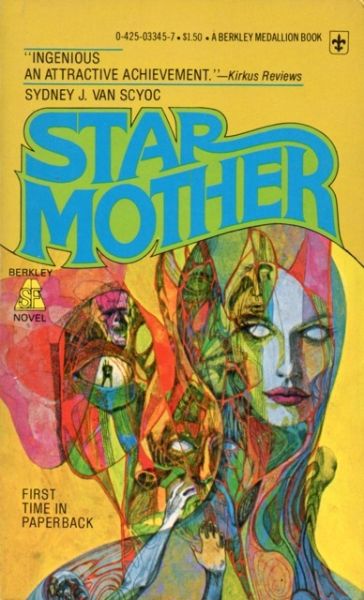Mother Mother
Starmother
By Sydney J. Van Scyoc

14 Feb, 2021
Sydney J. Van Scyoc’s 1976 Starmother is a standalone science fiction novel.
Cadet Jahna Swiss, of the Peace Service Corps, is astounded when she is pulled from her classes and dispatched to spend two years on Nedling, where she is to tend mutant children. Playing nanny falls well outside the traditional duties of the Peace Service.
Her first impression of Nedling is not promising.
Seemingly habitable worlds are a dime a dozen. The humourless religious fanatics who settled Nedling two hundred years previous have had the world to themselves, at least as far as other colonists from Earth go. It seems that they haven’t mellowed over that time. As Jahna realizes when she meets colony patriarch Humble Nodd, who dismisses Jahna as a tainted harlot, one of the irredeemable sinners from whom Nodd’s ancestors had fled.
Two years with the Fathers would be intolerable. Luckily for Jahna, the Fathers have no intention of allowing Jahna to sully the grim purity of Huttown. She is hustled off to Pengalen. Pengalen was an insane asylum, built to shelter those colonists whose minds snapped under the pressures of settling an alien world. Now it is a refuge for mutants that the Fathers of Huttown have cast out.
There is, it seems, a second community on Hedling, one that the Fathers have never mentioned to the other human worlds of the galaxy. The Father loath their neighbours. Nevertheless, they relayed a request from that community for Jahna’s services, while withholding important need-to-know information from the Corps.
Let’s back up a bit for some background info. When humanity settled alien worlds it discovered that one of the costs was an uptick in human mutations. The causes vary from world to world but the results are much the same: many offspring who differ from their parents. Most mutations are deleterious; some mutations are useful. If not obvious, these tend to spread with time.
It doesn’t at first seem that this will be the case on Nedling. The Fathers treasure purity. Mutant farm animals are killed; mutated crop species are uprooted and incinerated (even if they are better adapted to local conditions) or shunned. Clearly mutant babies are abandoned in the forests (presumably to die there) and their mothers are sanctioned. The mothers must be spiritually tainted if they can bear tainted offspring!
But … some babies were rescued by the native Dirads; the survivors form their own culture and take over Pengalen. Now there are two communities on Nedling: Huttown and the lands beyond Pengalen.
All communications with the Peace Service Corps are funneled through Huttown; they are censored. Jahna arrives knowing that she’s needed, but not where or by who. It’s a surprise to her when she’s sent to Pengalen.
What she finds: the mutations on Hedling aren’t random. Baby by baby, humanity is being reshaped into something new [1]. What is causing this she doesn’t know. What she does see is a clear need. Helping others is what she signed up to do.
~oOo~
People familiar with Disco Era SF and its often reductive, reproduction-centred view of female roles may be expecting the book to head in a fairly unsavoury direction where its attractive teen protagonist is concerned. Particularly since the plot is about shaping a New Race. This does not happen. The mutants need Jahna as a literal role model, not for any, uh, physically intimate purpose.
That said, various characters do toy with the notion of murdering her, which is less than ideal from her perspective.
While my synopsis may make Huttown’s culture sound unpleasant, I assure you that I haven’t given you enough detail to understand just how bad it is. Huttown colonists exist in a state of constant borderline famine and institutionalized abuse. The Fathers have managed to make life on an alien world more miserable than necessary. The people out in the woods have their own problems, but at least they aren’t needlessly starving.
Because Jahna is a cadet and not a trained biologist, precisely what is driving the directed alterations remains unclear. Presumably, Peace Corps training teaches cadets how to avoid panic, because Jahna is nowhere near as alarmed by what’s happening to the mutants as she might be. Indeed, the speed at which she embraces the role intended for her (as teacher and role model, nothing else) is startling. (It helps that books of this vintage were short, facilitating quick decisions on the part of the protagonists.)
The overall impression is of a kind of anti-Lovecraft SF tale. Humans discover enigmatic, eldritch forces working on them in very disturbing ways and are pretty cool with it.
As far as I can tell, Starmother is out of print.
1: This process is by no means perfect and the survival rate is well short of one hundred percent.
